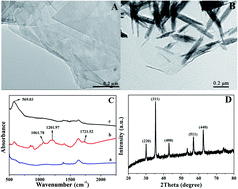A sensitive electrochemical sensor based on reduced graphene oxide/Fe3O4 nanorod composites for detection of nitrofurantoin and its metabolite
Abstract
In this work, a reduced graphene oxide/Fe3O4 nanorod composite (rGO/Fe3O4NR) modified glassy carbon electrode was fabricated for nitrofurantoin (NFT) and 1-aminohydantoin (AHD) detection. The structure of the synthesized nanocomposites was confirmed by transmission electron microscopy (TEM), Fourier transform infrared (FTIR) spectroscopy and X-ray diffraction (XRD). We synthesized rGO/Fe3O4NR composites with the advantages of larger specific surface area, more active sites, and higher conductivity than those of a single material. Meanwhile, they exhibited higher catalytic activity and efficiently accelerated electron transfer, thereby greatly enhancing the electrode’s performance. Under optimal conditions, the modified electrode exhibited a linear relationship in the NFT concentration range from 0.005 to 100 μmol L−1 with a detection limit of 1.14 nmol L−1. The linear range of AHD was 0.1 to 100 μmol L−1 with a detection limit of 83.1 nmol L−1. The recoveries of NFT and AHD were 91.10–94.07% and 92.93–97.94%, respectively. In addition, the proposed electrode displayed an excellent analytical performance with great reproducibility, stability and anti-interference ability. It was successfully utilized for the determination of NFT and AHD in real samples.

- This article is part of the themed collection: Analytical Methods Recent HOT articles


 Please wait while we load your content...
Please wait while we load your content...